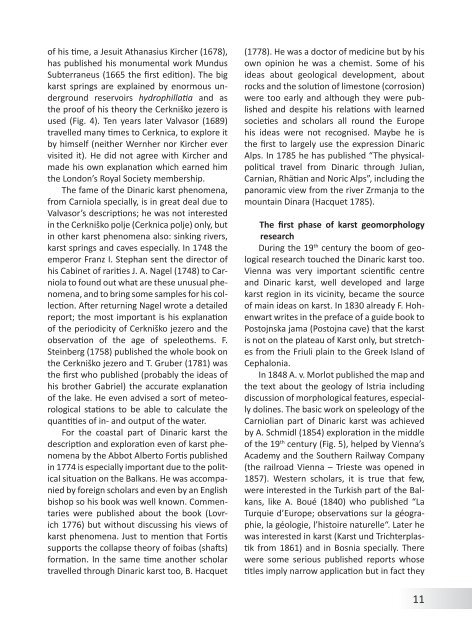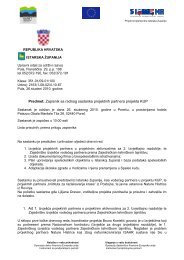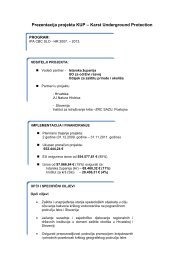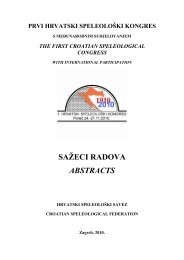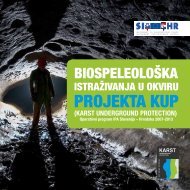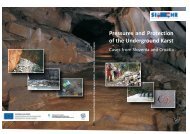Case Studies from the Dinaric Karst of Slovenia
Case Studies from the Dinaric Karst of Slovenia
Case Studies from the Dinaric Karst of Slovenia
Create successful ePaper yourself
Turn your PDF publications into a flip-book with our unique Google optimized e-Paper software.
<strong>of</strong> his time, a Jesuit Athanasius Kircher (1678),has published his monumental work MundusSubterraneus (1665 <strong>the</strong> first edition). The bigkarst springs are explained by enormous undergroundreservoirs hydrophillatia and as<strong>the</strong> pro<strong>of</strong> <strong>of</strong> his <strong>the</strong>ory <strong>the</strong> Cerkniško jezero isused (Fig. 4). Ten years later Valvasor (1689)travelled many times to Cerknica, to explore itby himself (nei<strong>the</strong>r Wernher nor Kircher evervisited it). He did not agree with Kircher andmade his own explanation which earned him<strong>the</strong> London’s Royal Society membership.The fame <strong>of</strong> <strong>the</strong> <strong>Dinaric</strong> karst phenomena,<strong>from</strong> Carniola specially, is in great deal due toValvasor’s descriptions; he was not interestedin <strong>the</strong> Cerkniško polje (Cerknica polje) only, butin o<strong>the</strong>r karst phenomena also: sinking rivers,karst springs and caves especially. In 1748 <strong>the</strong>emperor Franz I. Stephan sent <strong>the</strong> director <strong>of</strong>his Cabinet <strong>of</strong> rarities J. A. Nagel (1748) to Carniolato found out what are <strong>the</strong>se unusual phenomena,and to bring some samples for his collection.After returning Nagel wrote a detailedreport; <strong>the</strong> most important is his explanation<strong>of</strong> <strong>the</strong> periodicity <strong>of</strong> Cerkniško jezero and <strong>the</strong>observation <strong>of</strong> <strong>the</strong> age <strong>of</strong> speleo<strong>the</strong>ms. F.Steinberg (1758) published <strong>the</strong> whole book on<strong>the</strong> Cerkniško jezero and T. Gruber (1781) was<strong>the</strong> first who published (probably <strong>the</strong> ideas <strong>of</strong>his bro<strong>the</strong>r Gabriel) <strong>the</strong> accurate explanation<strong>of</strong> <strong>the</strong> lake. He even advised a sort <strong>of</strong> meteorologicalstations to be able to calculate <strong>the</strong>quantities <strong>of</strong> in- and output <strong>of</strong> <strong>the</strong> water.For <strong>the</strong> coastal part <strong>of</strong> <strong>Dinaric</strong> karst <strong>the</strong>description and exploration even <strong>of</strong> karst phenomenaby <strong>the</strong> Abbot Alberto Fortis publishedin 1774 is especially important due to <strong>the</strong> politicalsituation on <strong>the</strong> Balkans. He was accompaniedby foreign scholars and even by an Englishbishop so his book was well known. Commentarieswere published about <strong>the</strong> book (Lovrich1776) but without discussing his views <strong>of</strong>karst phenomena. Just to mention that Fortissupports <strong>the</strong> collapse <strong>the</strong>ory <strong>of</strong> foibas (shafts)formation. In <strong>the</strong> same time ano<strong>the</strong>r scholartravelled through <strong>Dinaric</strong> karst too, B. Hacquet(1778). He was a doctor <strong>of</strong> medicine but by hisown opinion he was a chemist. Some <strong>of</strong> hisideas about geological development, aboutrocks and <strong>the</strong> solution <strong>of</strong> limestone (corrosion)were too early and although <strong>the</strong>y were publishedand despite his relations with learnedsocieties and scholars all round <strong>the</strong> Europehis ideas were not recognised. Maybe he is<strong>the</strong> first to largely use <strong>the</strong> expression <strong>Dinaric</strong>Alps. In 1785 he has published “The physicalpoliticaltravel <strong>from</strong> <strong>Dinaric</strong> through Julian,Carnian, Rhätian and Noric Alps”, including <strong>the</strong>panoramic view <strong>from</strong> <strong>the</strong> river Zrmanja to <strong>the</strong>mountain Dinara (Hacquet 1785).The first phase <strong>of</strong> karst geomorphologyresearchDuring <strong>the</strong> 19 th century <strong>the</strong> boom <strong>of</strong> geologicalresearch touched <strong>the</strong> <strong>Dinaric</strong> karst too.Vienna was very important scientific centreand <strong>Dinaric</strong> karst, well developed and largekarst region in its vicinity, became <strong>the</strong> source<strong>of</strong> main ideas on karst. In 1830 already F. Hohenwartwrites in <strong>the</strong> preface <strong>of</strong> a guide book toPostojnska jama (Postojna cave) that <strong>the</strong> karstis not on <strong>the</strong> plateau <strong>of</strong> <strong>Karst</strong> only, but stretches<strong>from</strong> <strong>the</strong> Friuli plain to <strong>the</strong> Greek Island <strong>of</strong>Cephalonia.In 1848 A. v. Morlot published <strong>the</strong> map and<strong>the</strong> text about <strong>the</strong> geology <strong>of</strong> Istria includingdiscussion <strong>of</strong> morphological features, especiallydolines. The basic work on speleology <strong>of</strong> <strong>the</strong>Carniolian part <strong>of</strong> <strong>Dinaric</strong> karst was achievedby A. Schmidl (1854) exploration in <strong>the</strong> middle<strong>of</strong> <strong>the</strong> 19 th century (Fig. 5), helped by Vienna’sAcademy and <strong>the</strong> Sou<strong>the</strong>rn Railway Company(<strong>the</strong> railroad Vienna – Trieste was opened in1857). Western scholars, it is true that few,were interested in <strong>the</strong> Turkish part <strong>of</strong> <strong>the</strong> Balkans,like A. Boué (1840) who published “LaTurquie d’Europe; observations sur la géographie,la géologie, l’histoire naturelle“. Later hewas interested in karst (<strong>Karst</strong> und Trichterplastik<strong>from</strong> 1861) and in Bosnia specially. Therewere some serious published reports whosetitles imply narrow application but in fact <strong>the</strong>y11


